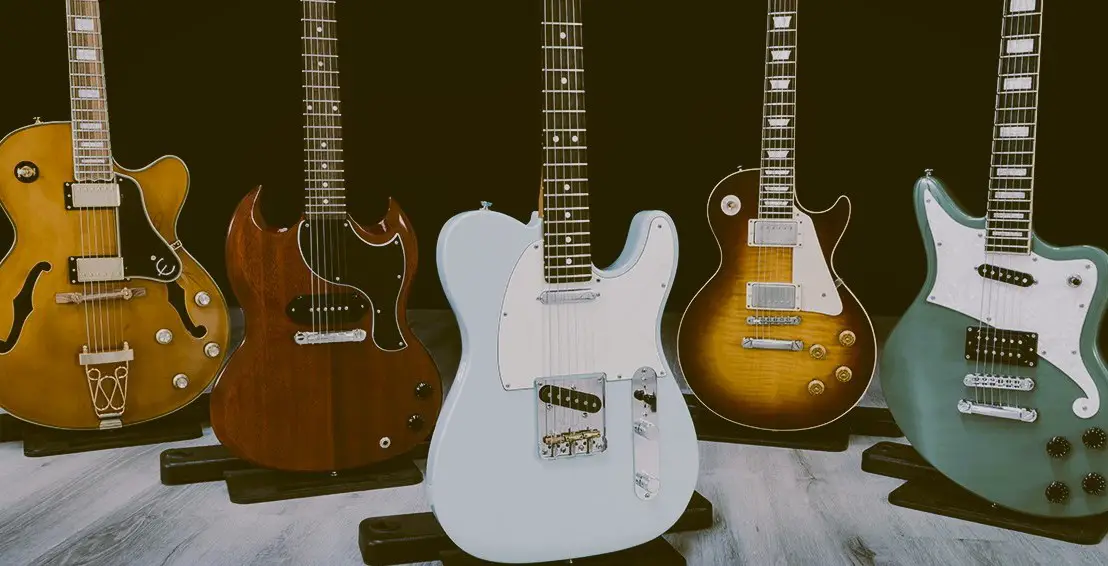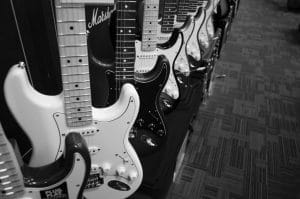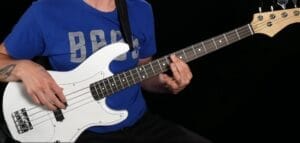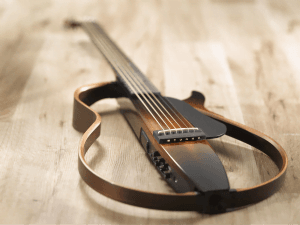Table of Contents
I have covered all significant guitar body styles in this blog! Knowing about different body styles is essential whether you’re new to guitars or have been playing for years. This blog will talk about electric and acoustic guitars and how their shapes affect how they sound and feel.
We’ve covered everything from big acoustic guitars that make a deep sound to slim electric guitars perfect for rock and roll.
Electric Guitar Body Types
The Stratocaster

History of the Stratocaster
Introduced by Fender in 1954, the Stratocaster was a revolutionary design featuring a contoured body for enhanced comfort and a “tremolo” arm for pitch manipulation. Its three single-coil pickups gave players a broader tonal palette, allowing for greater sonic versatility.
These features make the Strats more popular than other types of electric guitars.
Famous Stratocaster Players
Jimi Hendrix and Eric Clapton have showcased the Strat’s flexibility, while Stevie Ray Vaughan exploited its gritty tones.
The Telecaster

Brief History of the Telecaster
Designed by Leo Fender in 1950, the Telecaster is one of the first mass-produced solid-body electric guitars. Known for its simplistic design and twangy tone, its two pickups and no-contour body make it durable and easy to repair.
Famous Telecaster Players
Bruce Springsteen loves it for rock, and Keith Richards has used it extensively for rock and country styles.
The Les Paul

Brief History of The Les Paul
Co-designed by Les Paul and Ted McCarty and produced by Gibson, this 1952 innovation featured a mahogany body with a maple top, creating a rich, sustaining tone. The dual humbucker pickups reduced electrical interference, adding to its warm sound.
Famous Les Paul Players
From Slash’s rock solos to Jimmy Page’s legendary riffs, Les Paul has proven its versatility across genres.
The Flying V

Brief History of The Flying V
Gibson launched the Gibson Flying V 1958 as an avant-garde design that failed initially but was later embraced by the heavy metal and rock communities. The V-shape isn’t just for looks; it offers ergonomic advantages, allowing the guitar to be held more comfortably.
Famous Flying V Players
Albert King gave it blues credibility, while Jimi Hendrix and Kirk Hammett used it to rock out.
The Jazzmaster

Brief History of The Jazz Master
The Jazzmaster hit the scene in 1958, aiming to lure jazz musicians away from archtop guitars. It features a unique “offset waist” contour and innovative electronics like the dual-circuit design, giving players more tonal options.
Famous Jazzmaster Players
While not a massive hit in jazz, artists like Elvis Costello and J Mascis found its tonal variety well-suited for rock and indie.
The Rickenbacker

Brief History of the Rickenbacker
Emerging in the 1930s, Rickenbacker guitars were among the first to offer semi-hollow and solid-body designs. Unique for their “jangle” sound, they often feature a twelve-string variant.
Famous Rickenbacker Players
George Harrison’s use of a twelve-string Rickenbacker in the ’60s helped set the stage for folk-rock jangle.
The Gibson SG

Brief History of The Gibson SG
Unveiled in 1961 as a thinner, lighter alternative to the Les Paul, the Gibson SG offered easier upper-fret access thanks to its double-cutaway design. Despite its lighter weight, it packs a heavy, resonant tone.
Famous Gibson SG Players
Angus Young’s raucous solos and Tony Iommi’s heavy riffs in Black Sabbath showcase the SG’s ability to roar.
Check out more in-depth discussions regarding electric guitar body styles here.
Acoustic Guitar Body Styles
Dreadnaught

Brief History of Dreadnaught Guitars
Originating in 1916, the Dreadnaught’s larger body size offers a bold, loud sound, excellent for rhythmic strumming. Its wide bout and squared shoulders make it easily recognizable and provide a strong bass response.
Famous Players
Icons like John Denver and Elvis Presley used Dreadnaughts to create some of the most memorable acoustic recordings.
Grand Auditorium

Brief History Grand Auditorium Guitars
This Taylor original from the ’90s balances Dreadnaught and smaller body styles. Its versatility makes it a favorite for fingerstyle and strumming, offering a well-balanced tonal range.
Famous Grand Auditorium Players
Singers like Jason Mraz and Taylor Swift prefer the Grand Auditorium for its balanced sound and playability.
Grand Auditorium Cutaway

Brief History The Grand Auditorium Cutaway Guitar
Essentially a Grand Auditorium with a cutaway, this modification offers easier access to higher frets without sacrificing sound quality.
Famous Grand Auditorium Cutaway Players
John Mayer and Ed Sheeran find the valuable cutaway for more complex guitar work in their pop-infused styles.
Check out more in-depth discussions regarding acoustic guitar body styles here.
Stratocaster Vs. Telecaster: When to Play Which?
Ah, the age-old debate among Fender enthusiasts: Stratocaster or Telecaster? Well, the answer depends on what you’re after.

Stratocaster
The Strat might be your go-to if you’re into genres that demand tonal versatility, like jazz, blues, or rock. Its contoured body makes long playing sessions more comfortable, and its tremolo arm lets you dive into pitch-bending techniques. The Stratocaster’s three pickups provide a broader range of tonal possibilities.
Telecaster
If you’re looking for a workhorse that excels in country, rock, and even jazz, the Telecaster’s simpler electronics and body design make it rugged and straightforward. It’s famous for its piercing “twang,” making it a staple in country music and a choice pick for rockers like Keith Richards.
So, what’s your flavor? Do you need that tremolo arm and tonal diversity, or are you about raw, unfiltered sound?
Differences Between a Hollow Body and Solid Body Instruments
Solid Body
These are your standard rock and roll machines—think Stratocasters, Les Pauls, and Telecasters. Because they’re solid, they’re less prone to feedback, making them ideal for high-volume stage performance. They often offer a crisp, clear tonality suitable for intricate solos and riffs.

Hollow Body
These are more vintage in style and sound, typically used for jazz and blues. The hollow body provides a warmer, more resonant tone but can be prone to feedback at higher volumes. However, the acoustic resonance makes them great for clean, unamplified playing.

Do you see yourself shredding on stage or laying down jazzy chords in an intimate venue?
Which Guitar Body Style Stood Out in the Rock Music Era?
The Gibson Les Paul and Fender Stratocaster undoubtedly share the throne in rock music. Les Paul has been a favorite among rock legends like Slash and Jimmy Page because of its meaty, warm tones.

Meanwhile, icons from Jimi Hendrix to Eric Clapton have wielded the Stratocaster, known for its versatility. Both styles have carved out significant roles in defining the sound of rock music over the years.
So, are you more of a Les Paul powerhouse or a Stratocaster virtuoso?
Which Guitar Body Style Was Famous for Punk Music?
Regarding punk music, the Fender Telecaster often takes center stage. Its rugged design and piercing twang fit perfectly with punk’s raw energy. Artists like Joe Strummer of The Clash have wielded Telecasters to create some of punk’s most iconic sounds.

Is the rebellious spirit of punk calling out to you?
How to Choose the Perfect Acoustic Guitar Body Style?
Dreadnaught
If you’re a strummer looking for a loud, bold sound, the Dreadnaught’s large body will serve you well.
Grand Auditorium
If you need versatility for both fingerpicking and strumming, this could be your go-to. It’s a well-balanced choice for the singer-songwriter types.
Grand Auditorium Cutaway
If you want the benefits of a Grand Auditorium but also plan on venturing to higher frets, consider the cutaway option for better access.
Your choice depends on your playing style and the tonal qualities you value.
Are you leaning towards deep, resonant tones or something more balanced and versatile?
Understanding Your Musical Voice with Acoustic Guitars
The first question you should ask yourself is, “What’s my musical style?” Different genres and playing styles call for distinct guitar body shapes.
Strumming
Strats and Teles are excellent for strumming electric guitars due to their bright and chimney tones. Les Pauls and SGs, with their humbuckers, can also be great for strumming but provide a thicker, warmer sound.
For those who enjoy laying down chords and generating rich soundscapes, a larger-bodied guitar like the Dreadnaught or Jumbo offers the projection and fullness you’ll appreciate. Their larger air cavity creates a deeper resonance, perfect for strumming.
Fingerstyle
Fingerpickers often gravitate toward smaller, more responsive body styles. The Parlor, Concert, or Classical guitars offer the nuance and clarity that intricate fingerwork benefits from.
The Jazzmaster is often preferred for fingerstyle, with its soap bar pickups offering a warm but articulate tone. A Telecaster with its single-coil in the neck position can also be an excellent choice for fingerstyle players.
Versatility
If you are straddling multiple genres or techniques, consider a middle-ground option like the Grand Auditorium. It’s designed to efficiently handle both strumming and fingerstyle.
Stratocasters are highly versatile and can play everything from blues to rock to country. The three-pickup configuration offers a range of tonal possibilities, making them a go-to for many professional musicians.
Specific Genre Needs
Different genres have different needs, and your choice of body style can help you meet those.
Folk & Country
The strong projection of a Dreadnaught helps maintain clarity and volume, fitting for the storytelling nature of these genres.
Jazz & Classical
Smaller bodies with a well-balanced frequency response, like Grand Concerts or Nylon-String Classical guitars, are more attuned to the subtleties required in these styles.

Many players have made their mark in history by playing Jazz on Telecasters and Jazz Masters.
Pop & Indie
With their versatile tones and well-balanced nature, Telecasters can effortlessly adapt to various musical requirements, making them a popular choice for artists in these genres.
Metal
Flying V and Gibson SG are excellent choices for heavier genres, offering a sharper, more aggressive tone.

Indie and Alternative
Jazzmasters are often favored for their unique tonal palette, making them quite versatile.
Physical Aspects of Guitar Body Types
Don’t underestimate the comfort factor; a guitar that doesn’t feel right will be less enjoyable to play.
Size and Weight
Players with more petite frames may find large Dreadnaught or Jumbo guitars overwhelming. Concert or Parlor guitars could be more comfortable choices.
While the size of acoustic guitars is more rigidly defined, electric guitars like Stratocasters and Telecasters are generally lighter and more ergonomic.

Conversely, Les Pauls can be heavy, so sling one over your shoulder before committing.
Scale Length
Some smaller body styles offer shorter scale lengths, reducing string tension and making them easier to play.
In electric guitars, Fender models typically have longer scale lengths than Gibsons, which affects both tone and playability.
Materials Matter
The choice of tonewoods can significantly impact your guitar’s sound. Mahogany and Rosewood are popular for their warm, rich tones, while Spruce and Maple are known for their brightness and attack. Some high-end models offer exotic woods like Koa or Zebrawood for unique tonal characteristics.
Electric guitars also offer a range of tonewoods. Mahogany bodies are standard in Les Pauls for a warmer tone, while Alder and Ash are often used in Stratocasters for a brighter sound.
Consider the Budget
Whether you’re a beginner or a seasoned pro, there’s a guitar for every budget. But remember, you often get what you pay for. Brands like Martin, Taylor, and Gibson offer premium-quality guitars, but brands like Yamaha and Epiphone also offer reliable models for those on a tighter budget.

Please don’t underestimate the quality of brands like Squier or Epiphone; they offer excellent entry-level versions of their Fender and Gibson counterparts.
Fine Details
Cutaways
These offer easier access to higher frets, making them ideal for soloing and more complex fingerwork.
In-Built Electronics
A built-in pickup system can be a real asset if you intend to play in amplified settings.
Aesthetics
Your guitar should not only sound good but also be visually appealing. Consider the finish, binding, and inlays in your selection process.
FAQ
The most popular guitar body style tends to be the “Stratocaster” for electric guitars and the “Dreadnought” for acoustic guitars. These shapes are well-loved for their versatile sound and comfortable playability. They’ve been used by musicians in a variety of genres, making them a go-to choice for many.
The five basic guitar shapes are:
Stratocaster – Known for its contoured body and versatility, mainly seen in electric guitars.
Les Paul – Characterized by its solid, curvy body, also mainly an electric guitar style.
Dreadnought – A full-bodied acoustic guitar known for its rich, deep sound.
Jumbo – Larger than the Dreadnought, the Jumbo acoustic guitar offers a big, bold sound.
SG (Solid Guitar) – Another electric style, SGs are notable for their thin, flat bodies and double cutaways.
The most common guitar body style is arguably the “Dreadnought” for acoustic guitars and the “Stratocaster” for electric guitars. These models are frequently chosen for their balance of comfort, sound quality, and versatility.
Different guitar styles have distinct shapes that influence both their sound and playability. For example:
Stratocasters are versatile and great for a variety of music styles, from rock to jazz.
Les Pauls have a thicker, warmer tone ideal for blues and rock.
Dreadnoughts offer a balanced sound that’s suitable for strumming and fingerpicking.
Jumbos have a big, loud sound that fills the room, great for acoustic performances.
SGs are lightweight and offer easy access to higher frets, making them popular for fast solos.
- The Best 8 Cheap Bass Guitars - February 6, 2025
- Top 10 Best Budget Bass Guitars for Beginners - February 6, 2025
- Best 5 String Bass Guitars For Every Price Point - February 6, 2025








